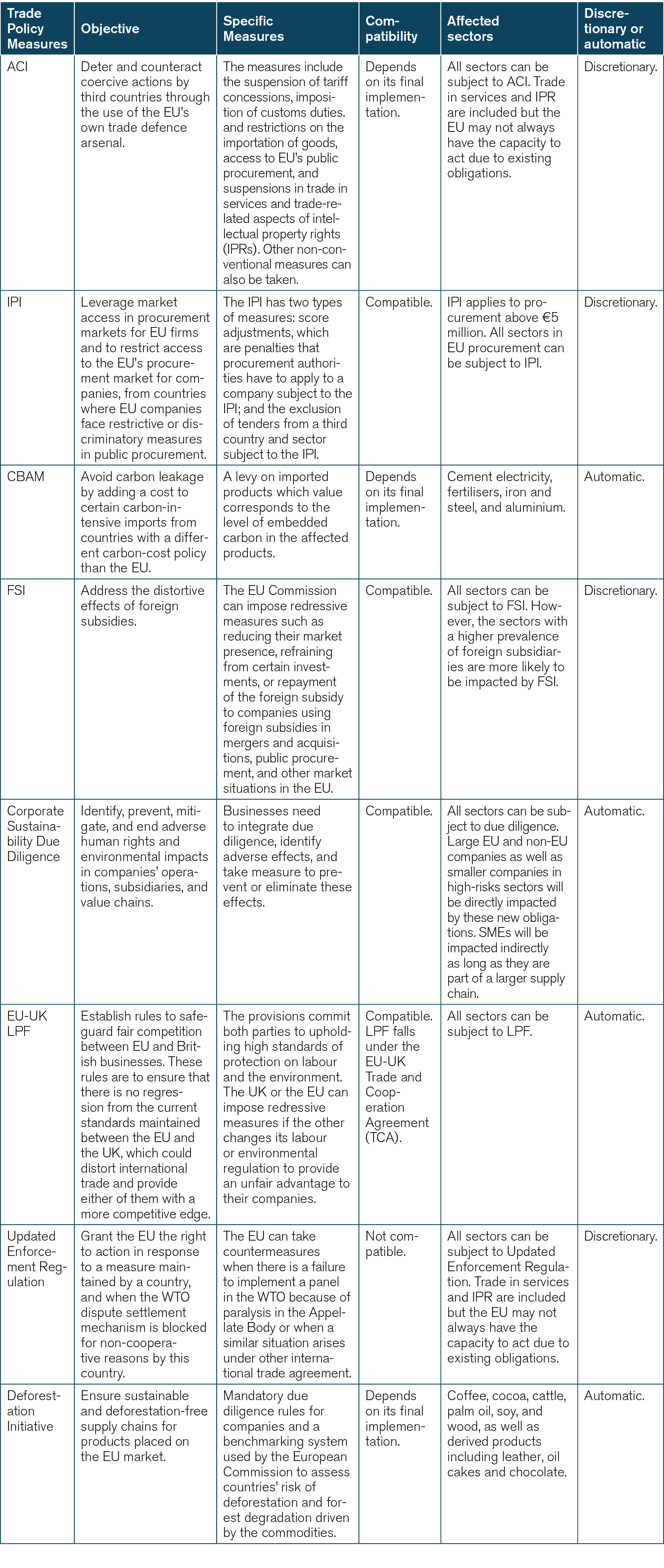The New Wave of Defensive Trade Policy Measures in the European Union: Design, Structure, and Trade Effects
Published By: Fredrik Erixon Oscar Guinea Philipp Lamprecht Vanika Sharma Renata Zilli
Subjects: European Union Trade Defence
Summary
This study undertakes a comprehensive review of proposed and adopted defensive trade policy instruments in the EU, with the purpose of better understanding their design, functioning, and implications. The study covers eight policy instruments at different stages of development. These are: Anti-Coercion Instrument (ACI), International Procurement Instrument (IPI), Carbon Border Adjustment Mechanism (CBAM), Foreign Subsidy Instrument (FSI), Corporate Sustainability Due Diligence (DD), Level Playing Field Provisions in the EU-UK Trade and Cooperation Agreement (LPF), Enforcement Regulation (ER), and the Deforestation Initiative (DI).
It is understandable that the EU seeks both redressive and retaliatory measures in its trade policy. However, these measures would have the total effect of Europe producing more for itself and being less dependent on imports. This is a significant policy shift, because in their totality the defensive trade policies make the EU more inward-looking. This can lead to major negative consequences. An extensive distortion of trade and markets would reduce the gains from trade and prompt a reallocation of European resources. Notably, the EU is a larger supplier of goods and services than it is a buyer, and an inward-looking policy that leads to retaliation from EU’s trading partners can harm its exports and trade surplus. There are also potential strategic consequences that could follow, and their importance has increased considerable as a result of the Russian war against Ukraine. Under these measures, the EU could introduce new trade frictions with friends and allies, and with countries that the EU seeks closer cooperation with to provide for a safer geopolitical environment.
For each of these defensive measures, the study takes an extensive look at the objectives of the instruments, their legality, proportionality, and subsidiarity, the working of the instruments and the division of labour between institutions, as well as their enforceability in conjunction with existing multilateral and bilateral rules affecting the EU. It also attempts to capture the impact and potential for retaliation for the EU and its partners as a result of the implementation of the instruments. The study highlights the areas where the instruments lack clarity, particularly in the implementation of the instrument, the division of labour between the EU and EU member states, and the compliance of the instruments with WTO rules and bilateral FTA provisions.
The instruments share some general characteristics. Many of the instruments have been created as retaliatory measures against coercion and unfair trade practices by partner countries. Very often, the partner countries most affected by the instruments are also the same. The United States, China, Russia, the UK, and Turkey are likely to be on the receiving end of the instruments due to the significant volumes of trade and economic interdependence with the EU, but also because they either do not follow the same trade rules as the EU, or the EU wants to maintain with them the current level of competitiveness. Most instruments also use restrictions to the EU market as the main policy lever. The objective is not just about creating an equal playing field but also ensuring that the rest of the world follows EU rules. Particularly, the EU aims at regulating non-EU companies directly and unilaterally through EU policies, which increases the risk of retaliation against the EU.
At the same time, there are also important areas of departure in the specifics of each instrument, as illustrated by the varying objectives, measures, compatibility with international obligation, affected sectors, and whether the measures apply automatically or at the discretion of the EU.
Table: Defensive trade policy measures
This report was commissioned and funded by the Confederation of Swedish Enterprise.